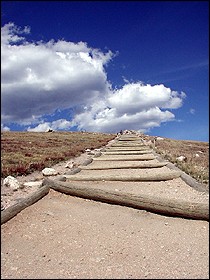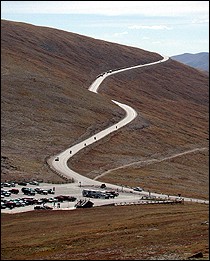

|
|
|
During September of 2000, DCSki’s Editor loaded his car up and headed west, with no fixed agenda - just a yearning for some adventure and fun.

|
|
Photo collage by M. Scott Smith.
|

|
|
Stairway to heaven. t may look like a heavenly hike, but with an elevation above 12,000 feet, you’ll be stopping every few steps to catch your breath. The Alpine Ridge Trail is short in distance but breathtaking in more than one way. (The panorama at the top of this article - created by joining seven images - was taken at top of this trail.) Photo by M. Scott Smith.
|
Having made it to the Rockies, I’ve left boring behind and kicked my trip into high gear. Destination #1: Rocky Mountain National Park.
Founded in 1915 as the nation’s tenth national park, Rocky Mountain National Park includes green valleys, aspen-dotted mountains, glaciers, and even tundra - a third of the Park is located above tree line. Tenants of the Park include elk, bighorn sheep, black bears, beavers, coyotes, deer, mountain lions, chipmunks, and lots of wide-eyed tourists.
Trail Ridge Road snakes its way through the Park, beginning at the Estes Park valley on the east and concluding in the Kawuneeche Valley on the west. The road climbs as high as 12,183 feet, offering plenty of overlooks to pull off and take in the scenery or wildlife. (Nearby mountain peaks top 14,000 feet.)
I expected Rocky Mountain National Park to be cold when I arrived. Trail Ridge Road usually closes for the season with the first snowfall, around mid-October. Weather within the Park can change drastically without notice; summer mornings often start off with a cloudless blue sky, but afternoon thunderclouds can roll in without warning. I brought warm clothes on my trip specifically with Rocky Mountain National Park in mind.

|
|
Trail Ridge Road. Trail Ridge Road snakes around the top of an above-treeline environment. Don’t forget to keep your eyes on the road. Photo by M. Scott Smith.
|
As it turns out, Colorado has been experiencing record-breaking warm temperatures. Temperatures in Denver climbed into the 90’s; several thousand feet above, at the lower elevations of Rocky Mountain National Park, daytime temperatures reached into the 80’s. Due to the dryness and a breeze, the temperatures were quite comfortable.
I pulled into the Moraine Park campground and selected a site. As the sun began to set, I got out my bike and took a quick ride through the campground, discovering that short hills require tremendous effort at 9,000 feet for sea level dwellers like me. Soon after the ride, I had my tent set up and a campfire roaring as I began to watch stars make an appearance in the darkening sky, one by one.
Alas, I had no food save a few granola bars and some Gatorade. But they sure tasted good.

|
|
Not that we’re boasting, but… A trailtop sign points out that Rocky Mountain National Park’s mountains are bigger than Oregon’s mountains. (Take that, you Oregonians.) Of course, you can ski on Mt. Hood year-round.. Photo by M. Scott Smith.
|
One pleasant surprise: no bugs. (After all, in my last journal entry, after describing all the bugs splattered across my windshield from the long drive, I promised this journal entry would be bug-free.) I expected some mosquitoes and came prepared with bug-spray, but due to a particularly dry summer in the Rockies, I didn’t see or swat at a single mosquito. Hey, I’m not complaining.
Once the sun had gone down, temperatures soon followed. I retired to my tent but didn’t sleep very well, not because temperatures dipped below freezing, but possibly due to the rowdiness of my neighbors. Not fellow campers, but some of the natives - bugling elk (also known as wapiti), howling coyotes, and an owl perched in a tree near my campsite who kept demanding to know who I was.
As I lie on my air mattress taking in the sounds, I concluded that all of these animals were making these noises for one simple reason: no, not to annoy me, but to impress the ladies. I didn’t mind being kept up by these sounds; where else can you hear the unearthly calls of an elk looking for a mate or a lone coyote’s yip being answered by a handful of howls miles away?
The next morning as I was starting to get around, an elderly man swung by my campsite and struck up a conversation. (This is standard fare at national parks; you simply don’t pass someone else without saying “hi.”)
“Did you see the bears last night?” the man asked.
“Uh, no,” I replied. “I did hear something walking around but didn’t investigate - figured it was just a deer or a camper.”
“Well, the bears were right by your campsite, so that was probably them. Probably good you didn’t investigate!” he answered.
I have never been bothered too much by bears. Rocky Mountain National Park has black bears but no grizzlies, unlike parks further north such as Glacier National Park. In a crowded campground, I haven’t been afraid of bears, although it’s been pointed out to me that fellow campers would probably not come rushing out of their tent to aid if you called for help during a bear attack - they’d stay in their tents and not make a sound. Hmm.
It’s probably good I didn’t poke my head out of the tent to see what was walking around.

|
|
Bear Lake. ne of the most popular (and crowded) destinations at Rocky Mountain National Park, Bear Lake is encircled by an easy-going, 0.5-mile trail. Photo by M. Scott Smith.
|
After a breakfast of - surprise - granola bars, and Gatorade - I headed to Bear Lake for a quick hike. Daily during the summer and weekends during the early fall, the Park Service runs a free shuttle between a parking lot and Bear Lake. The shuttle was running on the Thursday that I visited, but only because the parking lot at Bear Lake was closed to make space for a helicopter. The chopper was being used to shuttle materials to a remote trail for trail maintenance. A ranger explained that mules are usually used to pack in materials, but this job required a chopper.
A scenic and easy-going 0.5-mile traces the edge of Bear Lake, with lots of benches to sit at and plenty of photo ops. Several other trails branch off from this area.
I wrapped up my visit to Rocky Mountain National Park with a stop at the Alpine Visitor Center and an exhausting above-treeline hike up the Alpine Ridge Trail.
Next stop: Breckenridge, Colorado.
Tips for visiting Rocky Mountain National Park:
M. Scott Smith is the founder and Editor of DCSki. Scott loves outdoor activities such as camping, hiking, kayaking, skiing, and mountain biking. He is an avid photographer and writer.

Join the conversation by logging in.
Don't have an account? Create one here.